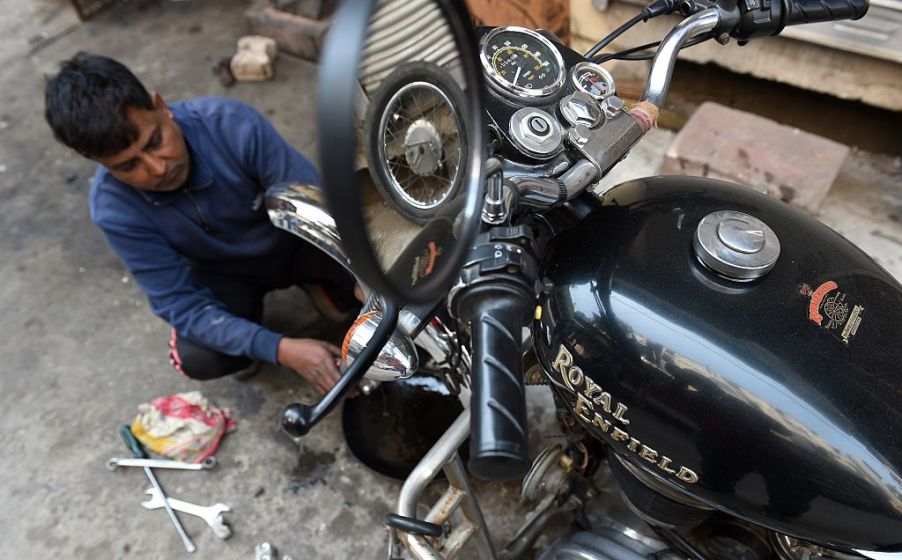
How to Change the Oil in Your Motorcycle
Changing the oil in your motorcycle yourself can save you money and the inconvenience of taking it to a professional. Even the most amateur of mechanics can master the art of DIY oil changes, with the proper instruction and supplies. And to help you avoid a costly visit to the shop, we’re here with everything you need to know to start changing the oil in your motorcycle yourself.
According to RideApart, how often your oil should be changed depends heavily on how much you use your motorcycle. As a general rule of thumb, the oil in your motorcycle should be changed at least once each year, or roughly every 3,000-5,000 miles. Of course, for motorcycles that assume a “harder” lifestyle, your oil should be changed more often.
Getting started with the right supplies and prep work
Before you get started changing out the oil in your motorcycle, you’ll need the right supplies. According to Shell, you should always begin with the manual to your motorcycle and the following supplies:
- New oil: use the manual to your motorcycle to ensure you use the right motor oil for your needs
- Rear stand
- Funnel
- Rags
- Gloves
- Safety goggles
- Wrench set, torque wrench, and a strap wrench
- Drain pan
- New oil filter
- Optional: oil drain plug sealing washer (when advised in the manual) and wood blocks (for securing and leveling your motorcycle)
Once you’ve gathered your supplies, you’ll need to move your motorcycle to flat, even ground where there is plenty of space to work. Secure your motorcycle with its stand or a rear-stand for further security. To ensure your motorcycle is level, you can also use wood blocks to secure each side. Now it’s time to get started.
Changing the oil in your motorcycle
The first step in changing the oil in your motorcycle is locating the oil drain plug and oil filter (for motorcycles that have one) on the bottom of the engine. Wipe the entire area clean with a rag and place your drain pan directly underneath the drain plug.
Next, use a wrench to start unscrewing the drain plug, using your hand to finish the job once it’s loosened. Allow the oil to drain from your engine into the drain pan for 30-60 minutes, or until it’s completely drained. Remember to store your drain plug somewhere safe to ensure it does not get lost.
While your oil is draining, you can remove the used oil filter from your motorcycle using your hand or strap wrench. Squeeze and pour out any excess oil from the filter into your drain pan and thoroughly wipe the entire area clean once completely drained of oil. If your motorcycle is due for a new oil filter, now is the time to install it.
Once the oil is completely drained and the area wiped clean, screw your oil filter back into position. According to Castrol Limited, it is advisable to lubricate the gasket with new, clean oil before screwing your oil filter back in. Screw your motorcycle’s oil filter back into position using your hand until it reaches its mating surface. Using either your hand or wrench, turn it another half- to full-turn to ensure it is secure. Do not over-tighten your oil filter. Use a rag to wipe clean the oil drain plug and the entire area.
Now it’s time to reinstall the oil drain plug. Find a wrench that works best with your plug and take note that it’s important to not over-tighten the plug. Once your oil plug is securely back in place, it’s time to add new oil.
Ensure you’re using the proper oil for your motorcycle by checking, and double-checking, your motorcycle manual. Use a quality funnel to pour the new oil into your engine, paying close attention to the proper amount of oil you need. Carefully remove your drain pan, funnel, and other supplies. Use a rag to clean up or wipe down any surfaces. Then it’s time to tidy up your area and start your motorcycle.
Starting the engine in your motorcycle gets the oil moving, so be sure to let it idle for a few minutes while the new oil warms and circulates. While it’s idling, observe your work area to ensure there are no leaks surrounding the oil plug and filter.
After running for a few minutes, check your oil level to ensure you have the proper amount necessary and always remember to record the date, time, and mileage so you know when your motorcycle needs its next oil change.
The last step in changing the oil in your motorcycle is oil disposal. Once you’ve changed your old oil, it’s essential that you store it in a safe place and dispose of it at a qualified recycling center.


